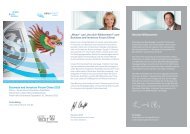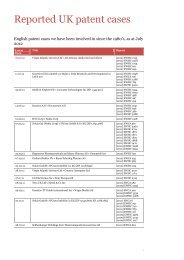Here - Bird & Bird
Here - Bird & Bird
Here - Bird & Bird
Create successful ePaper yourself
Turn your PDF publications into a flip-book with our unique Google optimized e-Paper software.
550 European Intellectual Property Review<br />
The Implications of<br />
L’Oréal v Bellure—A<br />
Retrospective and a<br />
Looking Forward: The<br />
Essential Functions of<br />
a Trade Mark and<br />
when is an Advantage<br />
Unfair?<br />
Audrey Horton *<br />
<strong>Bird</strong> & <strong>Bird</strong> LLP<br />
Comparative advertising; Essential function; EU law;<br />
Infringement; Trade marks; Unfair advantage<br />
This article reviews the judgment of the CJEU in L’Oréal<br />
v Bellure, and its application by the English Court of<br />
Appeal in L’Oréal itself and subsequent cases. The<br />
relevance of “intention” to take advantage of a famous<br />
mark is considered and general proposals for the future<br />
development of the law are drawn. The impact of the<br />
doctrine of the “essential functions” of a trade mark is<br />
considered in the light of L’Oréal, comments made by the<br />
Advocate General in his Opinion in Interflora v Marks<br />
& Spencer and the recently published Max Planck<br />
Institute’s Study on the European Trade Mark System.<br />
Background<br />
This article reviews the guidance of the Court of Justice<br />
of the European Union (CJEU) in L’Oréal v Bellure NV<br />
(C-487/07) in its judgment of June 18, 2009 1 and<br />
considers the application of that guidance by the English<br />
Court of Appeal in the L’Oréal case itself, 2 by the English<br />
Court of Appeal in Whirlpool Corp v Kenwood Ltd, 3 and<br />
the English High Court in Daimler AG v Sany Group Co<br />
Ltd 4 and Specsavers International Healthcare Ltd v Asda<br />
Stores Ltd. 5 The criticisms of the CJEU judgment by the<br />
English Court of Appeal in the L’Oréal v Bellure case<br />
are reviewed in a wider context, and in the light of the<br />
application of the judgment in subsequent cases. The<br />
relevance of intention to take advantage of the famous<br />
mark is considered. Finally a particular fact scenario in<br />
the entertainment field is considered in the light of the<br />
L’Oréal v Bellure principles, and some general proposals<br />
* The author would like to thank Trevor Cook of <strong>Bird</strong> & <strong>Bird</strong> LLP for kindly reading and commenting on this article.<br />
1 L’Oréal v Bellure NV (C-487/07) [2009] E.C.R. I-5185.<br />
2 L’Oréal v Bellure NV [2020] EWCA Civ 535; [2010] E.T.M.R. 47.<br />
3 Whirlpool Corp v Kenwood Ltd [2010] R.P.C. 2 CA (Civ Div).<br />
4 Daimler AG v Sany Group Co Ltd [2009] EWHC 2581 (Ch).<br />
5 Specsavers International Healthcare Ltd v Asda Stores Ltd [2010] EWHC 2035 (Ch); [2011] F.S.R. 1.<br />
6 Interflora v Marks & Spencer Plc (C-323/09) Opinion March 24, 2011.<br />
for the future development of the law including further<br />
referrals to the CJEU, in this area are drawn. In particular<br />
the impact of the doctrine of the “essential functions” of<br />
a trade mark is considered in the light of the L’Oréal v<br />
Bellure case, and comments made by the Advocate<br />
General in his Opinion in Interflora v Marks & Spencer<br />
Plc (C-323/09) 6 of March 24, 2011, and in the Study on<br />
the Overall Functioning of the European Trade Mark<br />
System by the Max Planck Institute (the Max Planck<br />
Study) of February 15, 2011.<br />
L’Oréal v Bellure: the judgment of the<br />
CJEU<br />
The L’Oréal case concerned so-called “smell-alike” or<br />
imitation perfumes and the use of well-known registered<br />
marks (TRESOR, MIRACLE, NOA and ANAIS-ANAIS)<br />
in price and smell comparison charts. The first issue<br />
referred to the CJEU concerned whether the use of<br />
registered word marks in the comparison lists fell within<br />
art.5(1)(a) of the Trade Marks Directive/art.9(1)(a) of the<br />
Trade Marks Regulation (2009/207) (identical marks and<br />
identical goods). The CFEU was asked whether the use<br />
of a registered trade mark on a comparison list for the<br />
purposes of indicating the characteristics, in particular<br />
the smell of the goods, in such a way that it did not cause<br />
any likelihood of confusion, did not affect sales under<br />
the well-known mark, did not jeopardise the essential<br />
function of the trade mark as a guarantee of origin, and<br />
did not tarnish or blur the registered trade mark, but<br />
played a significant role in the promotion of the product,<br />
could constitute infringement under art.5(1)(a)/art.9(1)(a).<br />
The CFEU held that an effect on any of the functions of<br />
the trade mark, such as the guarantee of quality of the<br />
goods or services, and those of communication,<br />
investment or advertising, and not just the origin function,<br />
is sufficient to sustain a claim under art.5(1)(a)/art.9(1)(a).<br />
The case also involved infringement under<br />
art.5(2)/art.9(1)(c) of L’Oréal’s registered marks for bottle<br />
shapes and packaging in respect of the defendant’s<br />
look-alike packaging (which did not incorporate L’Oréal’s<br />
word marks). Trade mark infringement occurs under<br />
art.5(2)/art.9(1)(c) where there is unauthorised use of a<br />
Community trade mark “which has a reputation in the<br />
Community”, in relation to identical, similar or<br />
non-similar goods and services, and where use of the sign<br />
“without due cause takes unfair advantage of, or is<br />
detrimental to, the distinctive character or repute of the<br />
Community trade mark”.<br />
The defendants were using the registered trade marks<br />
for the purposes of comparing the characteristics, in<br />
particular the smell of the goods, in such a way that it did<br />
not cause confusion, did not impair sales under the<br />
[2011] E.I.P.R., Issue 9 © 2011 Thomson Reuters (Professional) UK Limited and Contributors








